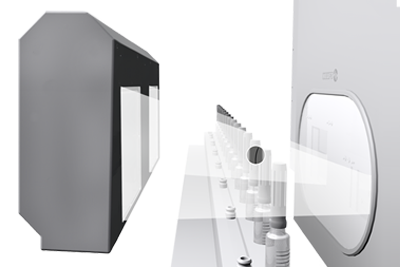Pre-fillable syringe inspection beyond the visible
Making bent needles and punctured protective caps visible. Only the HEUFT Syringer for the in-line inspection of pre-fillable syringes can do this. Pulsed X-rays are used for this purpose already in their production process.
Pre-filled syringes make an effective contribution to preventing the risk of incorrect or overdosing and drug misuse. In many cases, patients can inject themselves without the need for medical professionals. This is not the only reason why they are becoming increasingly important on the global pharmaceutical market.
Accordingly, comprehensive testing of their quality, functionality and integrity is becoming increasingly important. EU GMP Annex 1 "Manufacture of Sterile Medicinal Products", which came into force on August 25, 2023, therefore stipulates a 100% visual inspection when finishing pre-filled syringes: Immediately after filling and closing, the integrity of each of them must be checked using optical methods.
IPC during pre-fillable syringe production
The situation is different for pre-fillable syringe manufacturers during assembly and packaging, where this has not yet been required. Nevertheless, everything technically possible is already being done to establish an in-process control (IPC) that goes beyond merely randomly checking the integrity of packaging. They are therefore increasingly relying on the HEUFT Syringer for the continuous inspection of all units produced.
Instead of a visual inspection, it is the only one of its kind to carry out an X-ray-based ready-to-fill syringe inspection in order to make critical faults visible that occur during the final assembly step, when the needle guard is applied. They remain just as hidden to the human eye as they do to conventional camera technology.

New approach for previously uninspected quality aspects
We are talking about deformed and crookedly positioned needles in the needle shield as well as pierced soft or rigid needle shields (SNS / RNS), which threaten the sterility of the packaging and the microbial purity of its future contents. For the syringe manufacturer, the timely identification of these critical defects guarantees higher production quality. For the pharmaceutical manufacturer, it offers effective protection against costly packaging and drug waste: Affected single-use syringes are not only discovered and disposed of when the high-priced preparation is already contained, but are withdrawn from circulation long before they are filled.
For the first time, needle angle and puncture detection is made possible by the use of pulsed radiometric technology, which is exclusively available from us. Designed as a compact module for integration in the linear flow, the HEUFT Syringer has already enriched the IPC in more than 30 lines for the assembly and packaging of pre-fillable syringes worldwide with a new inspection approach for previously uninspected quality aspects.

Pulsed X-rays, intelligent analysis
Two X-ray images of each syringe are taken and stereoscopically combined. This is done without contact and can be carried out in both continuous and pulsed motion. Even in high-speed lines the pulsed X-ray inspection keeps pace – and generates high-resolution images with unrivalled low radiation which are intelligently denoised and analyzed by our HEUFT reflexx A.I. real-time image processing system in order to identify the most diverse characteristics of the pre-fillable syringes, their cannulas and protective caps as clearly as possible.
Each of them acts as a reference so that the relative position of the injection needle in relation to the central axis of the syringe body as well as to the outer edges of the needle guard can be precisely determined during needle angle detection. The unique X-ray flash technology also ensures that the images remain as free of motion blur as possible.

Uncomplicated integration, reliable detection
No complex radiation protection measures are required for the uncomplicated direct integration of the compact HEUFT Syringer into both new and existing systems. The safely enclosed X-ray module is also suitable for use in hygienically sensitive laminar flow areas. As an alternative to direct integration into pre-filled syringe processing machines, it is also available as a stand-alone unit.
Bent needles, incorrectly fitted or damaged Luer lock screw adapters and tamper-evident closures and, above all, punctured SNS and RNS are made visible for the first time during the production process of pre-fillable syringes. This even applies to needle shields that are only punctured but not completely pierced and can cause so-called micro-hooks on the tip of the cannula. These are tiny deformations of the needle tip that make an injection impossible or unnecessarily painful

GMP-compliant finished syringe inspection
The lean module is able to completely replace conventional optical detection units, e.g. for only checking the presence of the needle guard: Ready-to-fill syringes which completely lack this are detected by the pulsed X-ray inspection in any case so that more and more manufacturers are relying solely on the HEUFT Syringer and saving themselves additional optical checks.
With tamper-proof personalized access rights, a seamless audit trail protocol and batch balancing including counter statistics it complies with the FDA specifications of 21 CFR Part 11. The HEUFT PROFILER realizes the seamless recording, network-based transmission and long-term archiving of operating and batch data, test protocols and detection images. Basic documentation and validation obligations in accordance with GMP and GAMP5 are reliably fulfilled.
![]()
Effective protection against drug waste
As a fundamental component of quality management, the HEUFT Syringer not only enriches the IPC with new inspection approaches and detection options, but also Good Manufacturing Practices in the production of pre-filled syringes as a whole: instead of random checks of a few, a 100% X-ray inspection of every single one of them takes place, making the previously invisible visible and thus making an important contribution to the required patient safety and at the same time against pointless packaging and drug waste.


